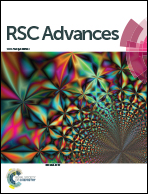Electrically conductive nanofibrous scaffolds based on poly(ethylene glycol)s-modified polyaniline and poly(ε-caprolactone) for tissue engineering applications
Abstract
The purpose of this study was to design and develop electrically conductive nanofibrous scaffolds based on poly(ethylene glycol)s-modified polyaniline [PEGs-b-(PANI)4] and poly(ε-caprolactone) (PCL) for tissue engineering applications. For this purpose, two AB4 miktoarm star-shaped conductive PEG2000-b-(PANI)4 and PEG6000-b-(PANI)4 were synthesized through a multistep process started from diepoxylated PEGs, and subsequently hydrolyzed to PEGs ends-caped tetraol [PEGs(OH)4]. Afterward, phenylamine-functionalized PEGs AB4 macromonomers (PhAPEGsM) were synthesized by functionalization of PEGs(OH)4 with p-anthranilic acid. The macromonomers obtained were subsequently used in chemical oxidation copolymerization with aniline monomer to produce AB4 miktoarm H-shaped conductive polymers. The solutions of the synthesized polymers and PCL were electrospun to produce uniform, conductive, and biocompatible nanofibers. Some physicochemical properties of these nanofibers such as morphologies, electrical conductivities, hydrophilicities, and mechanical properties were investigated. The biocompatibilities of the fabricated nanofibers were confirmed by assessing the adhesion, viability and proliferation of mouse fibroblast L929 cells using SEM and MTT assay, respectively. As the results, of the conductivities, biocompatibilities, hydrophilicities, and mechanical properties assessments it is demonstrated that these nanofibers are potentially suitable as scaffolds for use in tissue engineering that requires electroactivity.


 Please wait while we load your content...
Please wait while we load your content...